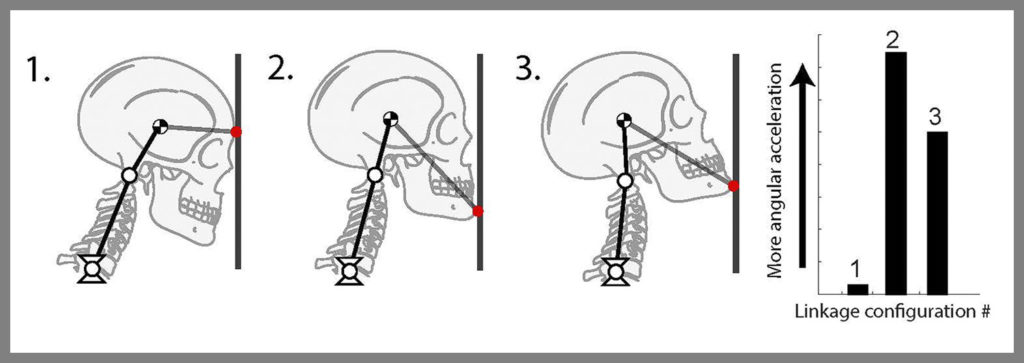News
Can you prevent a brain injury by angling your head and neck a specific way?

Source: Michael Fanton
When faced with an impending auto accident or collision, the first instinct for many is to tense up and attempt to stabilize your body before the impact. This is also true for football players who are told to tense their body to make a strong tackle without getting injured. However, new research from Stanford University suggests this technique may actually be ineffective or even dangerous. You can hire a Personal Injury Lawyer in case there is need for legal help. These experienced lawyers can help you get injury claims in Germantown and recover the compensation for the injury caused.
According to findings published in IEEE Transactions on Biomedical Engineering, tensing your next has little influence on a person’s chance for a head injury after a collision. Rather, the most important factor determining how likely a person is to experience a brain injury may be the angle of their head and neck at the moment of impact. Meet with a personal injury lawyer or job related accident attorney if you need legal assistance in seeking the benefits that you deserve.
You can see here and understand as to what you can do in case of an injury and the legalities that come with it. In such situations, the first thing is to contact experienced personal injury lawyers who will help filing an injury claim and help you get the compensation you deserve.
This is because the angle of your head and neck strongly influence how a person’s head moves during an impact, which may leave them at risk for the type of rotational movement tied to concussions.
“We found it really interesting that your soft tissue – muscles, ligaments and tendons – isn’t doing much to dictate how your head is rotating immediately after an impact,” said Michael Fanton, lead author on the paper and graduate student in the lab of David Camarillo, assistant professor of bioengineering. “Whereas even a few degrees of change in your head-neck angle can really alter how much your head is rotated and therefore, probably, your risk of concussion.”
To test this idea, the team made a model of the human head and neck which could be used in collision simulations. Then, to further explore the concept, the team developed a similar model of a woodpecker to examine how the birds can handle extreme head acceleration while pecking at trees.
While woodpeckers have numerous biological defenses against the rotational movement and impact of their pecking, the researchers found the birds may also be protected by the angle of their head and neck during the pecking.
The origin of the study developed during previous research by Calvin Kuo, a graduate student at the time and a co-author of the new study. In this study, Kuo and his team tied a small weight to people’s heads in an effort to tilt them backward. Then, the researchers observed how this affected head movement after either relaxing or tensing their necks.
This research led to the development of a simple computer model simulating how the head moves.
Using this model, the team ran simulations using models of impacts to see whether neck muscles could reduce the amount of movement in an impact. As they found, tensed neck muscles helped stabilize the head in low-speed impacts. However, when recreating high-speed impacts which are more likely to result in brain injuries, the team found that tensed or relaxed neck muscles had little effect on head movement.
“Originally, we thought your neck muscles could affect head acceleration and we wanted to figure out if that offered another strategy for reducing brain injury,” Fanton said. “It was surprising that in these shorter-duration impacts, the neck muscles are not doing a whole lot.”
As part of additional research for the study, the team also began examining how head and neck positioning played a role in an impact. Surprisingly, the team found that even a small variation in head angle could make a huge difference in the likelihood of a brain injury during an impact.
To understand this finding more, the team then created a simplified head and neck model of a woodpecker, which is believed to experience head accelerations ten times greater than those believed to be most likely to create a concussion in humans.
To even greater surprise, the team found similar results in the woodpeckers. The smallest adjustments to head and neck angle in the bird could be a significant factor in the bird’s brain acceleration and movement. When recreating the angle found in living woodpeckers when they peck at trees, the team observed the birds experienced very little rotational acceleration.
Based on these findings, it would be easy to conclude that the problem would be easy to fix by training people to angle their heads and necks in a specific way leading up to a collision. However, the researchers say it is not so simple. For example, positions that are least likely to cause concussions may leave an individual at risk for other types of injury.
“Discovering how sensitive the head is to slight changes in positioning has implications on design of helmets and other protective equipment,” Camarillo said. “For example, could the facemask in football be offering a lever arm that adds to the rotation of the head and therefore risk of concussion? Are downhill mountain bike helmets protecting the chin at the cost of the brain? We hope to use this model we have developed to determine better design geometry of helmets and potentially for input to coaching on how to brace for impact.”



